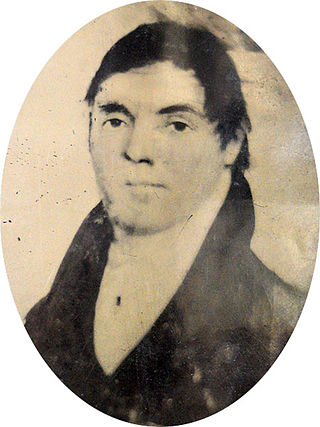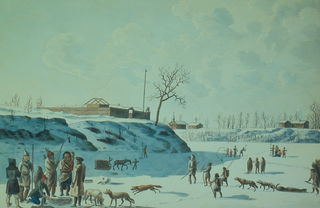
The Red River Colony, also known as Assiniboia, was a colonization project set up in 1811 by Thomas Douglas, 5th Earl of Selkirk, on 300,000 square kilometres (120,000 sq mi) of land in British North America. This land was granted to Douglas by the Hudson's Bay Company in the Selkirk Concession. It included portions of Rupert's Land, or the watershed of Hudson Bay, bounded on the north by the line of 52° N latitude roughly from the Assiniboine River east to Lake Winnipegosis. It then formed a line of 52° 30′ N latitude from Lake Winnipegosis to Lake Winnipeg, and by the Winnipeg River, Lake of the Woods and Rainy River.

Cuthbert "James" Grant was a Métis leader of the early 19th century who participated in the Pemmican War as an employee of the North West Company.

Thomas Douglas, 5th Earl of Selkirk FRS FRSE was a Scottish peer. He was noteworthy as a Scottish philanthropist who sponsored immigrant settlements in Canada at the Red River Colony.

In January 1814 Governor Miles MacDonell, appointed by Thomas Douglas, 5th Earl of Selkirk issued to the inhabitants of the Red River area a proclamation which became known as the Pemmican Proclamation. The proclamation was issued in attempt to stop the Métis people from exporting pemmican out of the Red River district. Cuthbert Grant, leader of the Métis, disregarded MacDonell's proclamation and continued the exportation of pemmican to the North West Company. The proclamation overall, became one of many areas of conflict between the Métis and the Red River settlers. Thomas Douglas, 5th Earl of Selkirk had sought interest in the Red River District, with the help of the Hudson's Bay Company as early as 1807. However, it was not until 1810 that the Hudson's Bay Company asked Lord Selkirk for his plans on settling in the interior of Canada.

Robert Semple was an American-born fur trader and merchant who served as governor of the territories controlled by the Hudson's Bay Company in the Canadas from 1815 until his death in 1816.
Pierre Guillaume Sayer was a Métis fur trader who challenged the monopoly of the Hudson's Bay Company (HBC) of the fur trade in the Red River region. Ultimately this led to its end.

Miles MacDonell was the first governor of the Red River Colony, a 19th-century Scottish settlement located in present-day Manitoba and North Dakota.

Fort Douglas was the Selkirk Settlement fort and the first fort associated with the Hudson's Bay Company near the confluence of the Red and Assiniboine rivers in today's city of Winnipeg. Named for Thomas Douglas, 5th Earl of Selkirk, founder of the Selkirk Settlement, the fort was built by Scottish and Irish settlers beginning in 1813. Completed in 1815, it was in the immediate vicinity of the North West Company establishment, Fort Gibraltar.

Fort Gibraltar was founded in 1809 by Alexander Macdonell of Greenfield of the North West Company in present-day Manitoba, Canada. It was located at the confluence of the Red and Assiniboine rivers in or near the area now known as The Forks in the city of Winnipeg. Fort Gibraltar was renamed Fort Garry after the merger of North West Company and the Hudson's Bay Company in 1821, and became Upper Fort Garry in 1835.
Fort Espérance was a North West Company trading post near Rocanville, Saskatchewan from 1787 until 1819. It was moved three times and was called Fort John from 1814 to 1816. There was a competing XY Company post from 1801 to 1805 and a Hudson's Bay post nearby from 1813 to 1816. It was on the Qu'Appelle River about 20 km from that river's junction with the Assiniboine River and about 7 km west of the Manitoba border. It was on the prairie in buffalo country and was mainly used as a source of pemmican which was sent down the river to Fort Bas de la Rivière at the mouth of the Winnipeg River.

Colin Robertson was an early Canadian fur trader and political figure. Born in Scotland, for much of his adult life he was engaged in the North American fur trade, working at different times for the North West Company and the Hudson's Bay Company. He led the Hudson's Bay Company expedition to Lake Athabasca.

The Selkirk Concession was a land grant issued by the Hudson's Bay Company (HBC) to Thomas Douglas, 5th Earl of Selkirk, in 1812. The Hudson's Bay Company held a commercial monopoly in Rupert's Land, consisting of the entire Hudson Bay drainage basin. The Selkirk Concession, also known as Selkirk's Grant, included a large section of the southwest area of Rupert's Land, bounded: on the north by the line of 52° N latitude roughly from the Assiniboine River east to Lake Winnipegosis, then by the line of 52° 30′ N latitude from Lake Winnipegosis to Lake Winnipeg; on the east by the Winnipeg River, Lake of the Woods and Rainy River; on the west roughly by the current boundary between modern Saskatchewan and Manitoba; and on the south by the rise of land marking the extent of the Hudson Bay watershed. This covered portions of present-day southern Manitoba, northern Minnesota and eastern North Dakota, in addition to small parts of eastern Saskatchewan, northwestern Ontario and northeastern South Dakota.

Lt.-Colonel The Hon. William McGillivray, of Chateau St. Antoine, Montreal, was a Scottish-born fur trader who succeeded his uncle Simon McTavish as the last chief partner of the North West Company until a merger between the NWC and her chief rival - the Hudson Bay Company. He was elected a member of the Legislative Assembly of Lower Canada and afterwards was appointed to the Legislative Council of Lower Canada. In 1795, he was inducted as a member into the Beaver Club. During the War of 1812 he was given the rank of lieutenant colonel in the Corps of Canadian Voyageurs as he was the highest up in the NWC's business hierarchy; the ranks of the Corps reflected one's position within the NWC as the Company had created the Corps under their own volition, and using employees as soldiers. He owned substantial estates in Scotland, Lower and Upper Canada. His home in Montreal was one of the early estates of the Golden Square Mile. McGillivray Ridge in British Columbia is named for him, as well as a handful of elementary schools in Ontario, Quebec, or British Columbia.
St. Laurent is a community on the eastern shore of Lake Manitoba. It lies within the boundaries of the Rural Municipality of St. Laurent, 70 km (43 mi) from Winnipeg. A historically-Métis settlement, St. Laurent is one of the few remaining places in which the Michif French language is still spoken.
Fur trading on the Assiniboine River and the general area west of Lake Winnipeg, in what is now Manitoba, Canada, began as early as 1731.
The Iron Confederacy or Iron Confederation was a political and military alliance of Plains Indians of what is now Western Canada and the northern United States. This confederacy included various individual bands that formed political, hunting and military alliances in defense against common enemies. The ethnic groups that made up the Confederacy were the branches of the Cree that moved onto the Great Plains around 1740, the Saulteaux, the Nakoda or Stoney people also called Pwat or Assiniboine, and the Métis and Haudenosaunee. The Confederacy rose to predominance on the northern Plains during the height of the North American fur trade when they operated as middlemen controlling the flow of European goods, particularly guns and ammunition, to other Indigenous nations, and the flow of furs to the Hudson's Bay Company (HBC) and North West Company (NWC) trading posts. Its peoples later also played a major part in the bison (buffalo) hunt, and the pemmican trade. The decline of the fur trade and the collapse of the bison herds sapped the power of the Confederacy after the 1860s, and it could no longer act as a barrier to U.S. and Canadian expansion.

The Pemmican War was a series of violent confrontations between the Hudson's Bay Company (HBC) and the North West Company (NWC) in the Canadas from 1812 to 1821. It started after the establishment of the Red River Colony by Thomas Douglas, 5th Earl of Selkirk in 1812, and ended in 1821 when the NWC was merged into the HBC. The conflict was sparked by the Pemmican Proclamation issued by Governor Miles Macdonell, which forbade any person from exporting pemmican, a key foodstuff for those involved in the North American fur trade, out of the Red River Colony. This was fiercely opposed by the Métis, who were mostly affiliated with the NWC and opposed to both the colony and the HBC's dominance in the region.

Métis buffalo hunting began on the North American plains in the late 1700s and continued until 1878. The great buffalo hunts were subsistence, political, economic, and military operations for Métis families and communities living in the region. At the height of the buffalo hunt era, there were two major hunt seasons: summer and autumn. These hunts were highly organized, with an elected council to lead the expedition. This made sure the process was fair and all families were well-fed and provided for throughout the year.
Pierre Chrysologue Pambrun was a French Canadian militia officer and later a fur trader in the service of the Hudson's Bay Company. Pambrun fought against the United States in the War of 1812, in particular the Battle of the Châteauguay. He joined the HBC during a time of turmoil with its competitors, the North West Company. After the Battle of Seven Oaks, he was among those held captive by men employed by the NWC.

Lawrence J. Barkwell was a Canadian author, editor, historian and lecturer, best known for his comprehensive writings on the Métis Nation and Culture. He served as senior historian at Manitoba Métis Federation’s Louis Riel Institute from 2006 until his death in September 2019. He was a member of the board of directors of the Friends of Upper Fort Garry. He was Honorary Elder for the St. Norbert Parish la Barrière Métis Council.















